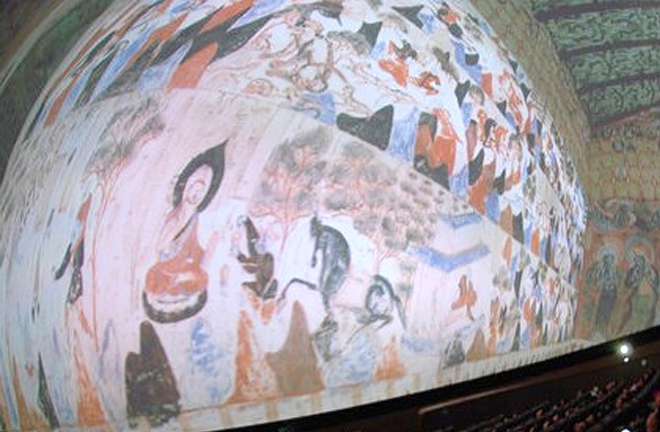Public art has more than aesthetic value

Audiences watch the Mogao Grottoes show demonstrated by means of multi-media and digital technology. Photo: FILE
With the continuous development of China’s economy and society, city building is advancing towards more ecologically minded living. As an important public cultural service that improves quality of life, public art is blossoming.
It is commonly believed that public art refers to the designs and artworks stored in public spaces and which can be freely participated in and appreciated by members of society. It mainly includes traditional forms such as murals, sculptures, installations and landscapes, and it also covers newer artistic forms such as landscape art, light and shadow art, and interactive art. The discussions on the function of public art in academia and art circles mainly focus on its aesthetic value, the value of tourism and how it may enhance the quality of city life. However, the education value of public art is given less attention. In fact, the most prominent feature of public art is its attribute of being public, which means communication, dialogue and exchange. This endows it with unique advantages in humanistic education and moral cultivation.
However, the development of public art now faces some problems: deficiency of humanistic concern; limited participation from the general public; short lifespan of art works, etc. To fully utilize the role of public art and effectively solve these problems, its educational function should be more valued. This could be approached in five ways.
First, the status of public art should be improved. Public art should not only be defined as the “name card” of a city beautifying the urban environment and shaping the city’s temperament. It needs to be considered as an important means for shaping the core values of society and enhancing the soft power of a country. Due to the fact that there is no legislation on public art at the national level in China, some departments only stipulate rules via local regulations from the perspective of the source of funds, landscape and so on. The educational value of public art is thus neglected. In terms of urban public art planning, it is suggested that the embodiment of socialist core values and the promotion of traditional and regional culture should be taken as the primary evaluation standards in the process of public art program applications.
The second approach is to listen to public opinions and accept the public’s judgment. Relevant mechanisms should be improved and detailed provisions should be made regarding the process of gathering project proposals, media communication, hearings, public voting, questionnaires, public display, evaluation and deliberation. The public’s participation should be fully ensured. In their artistic process, artists have the obligation to explain their ideas and methods of creation to the public and to accept supervision and listen to suggestions.
Third, as a kind of social aesthetic, public art needs to be integrated into the current education system and be combined with family education and school education to better play its role. Schools should be encouraged to incorporate local public artworks into textbooks as an important part of art education; artists and designers should be encouraged to visit communities and schools, introduce their own works and popularize public knowledge of art.
The fourth is to directly confront the most discussed public issues of the times. Public art has never existed “for art’s sake.” By thinking through social problems and paying attention to vulnerable groups, public art stirs the public to reflect. Therefore, artists should be present in the people’s daily lives, understand their joys and sorrows and present their feelings and desires in the works.
The last is to bring in high-tech and innovate with forms of expression. We live in an era of rapid change in science and technology, and new ways to create public art are constantly emerging. For example, digital projection, interactive devices, virtual reality and Unmanned Aerial Vehicle shows are all art forms that have recently arisen. These new forms have great public appeal. Therefore, artists should boldly embrace new technologies to create better and more moving works.
Ideal public art does not just make the city more beautiful, but also better. Placing a high premium on the humanistic and educational value of public art will lay a solid foundation for its long-term and healthy development.
Wang Chenhui is from the College of Creative Culture and Communication.
edited by BAI LE
